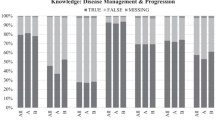Abstract
Southeast Asians have higher liver cancer rates than any other racial/ethnic group in the US. Approximately 80 percent of liver cancers are etiologically associated with hepatitis B virus (HBV) infection which is endemic in Southeast Asia. An in-person survey of Cambodian women (n = 320) was conducted in Seattle, Washington, during 1999. The questionnaire included items about HBV knowledge, beliefs, and practices. Prior to being provided with a description of the disease, only about one-half (56 percent) of our respondents had heard of HBV infection. Less than one-quarter (23 percent) of the study group thought that asymptomatic individuals can transmit the disease to others. Most thought that HBV infection can cause liver cancer (54 percent) and death (72 percent). However, a minority thought that infection can be lifelong (24 percent) and incurable (15 percent). Only 38 percent reported they had been serologically tested for HBV. Finally, of those who had been tested and thought they were susceptible, two-thirds (67 percent) had not been vaccinated. Lower levels of education were associated with lower levels of HBV knowledge and serologic testing. Our findings suggest that Cambodian immigrants have low levels of HBV knowledge, serologic testing, and vaccination; and demonstrate a need for targeted educational interventions aimed at reducing HBV-related liver cancer mortality among Southeast Asian communities.
Similar content being viewed by others
REFERENCES
US Department of Commerce. We the Asian Americans. Washington DC: US Department of Commerce, 1993.
Rumbaut RG, Weeks, JR. Fertility and adaptation: Indochinese refugees in the United States. Int Migrat Rev 1986; 20: 428–465.
Kulig JC. Sexuality beliefs among Cambodians: implications for health professionals. Health Care Women Int 1994; 15:69–76.
Kiernan B. Genocide andDemocracy in Cambodia: the Khmer Rouge, the UnitedStates, andthe International Community. New Haven: Yale University Press, 1993.
Muecke MA. Caring for Southeast Asian refugee patients in the USA. Am J Public Health 1983; 73:544–548.
Uba L. Cultural barriers to health care for Southeast Asian refugees. Public Health Rep 1992; 107: 544–546.
Di Bisceglie AM, Rustgi VK, Hoofnagle TH, Dusheiko GM, Lotze ML. NIH conference: hepatocellular carcinoma. Ann Intern Med 1988; 108:390–401.
London WT, McGlynn KA. Liver cancer. In D Scottenfeld and JF Fraumeni (Eds). Cancer Epidemiology andPrevention 772-793. New York: Oxford University Press, 1996.
Perkins CL, Morris JR, Wright WE, Young JL. Cancer Incidence and Mortality in California by DetailedRace/ ethnicity, 1988-92. Sacramento: California Department of Health Services, 1995.
Miller BA. Racial/ethnic Patterns of Cancer in the UnitedStates, 1988-1992. Bethesda: National Cancer Institute, 1996.
Johnson PJ. The epidemiology of hepatocellular carcinoma. Eur J Gastroenterol Hepatol 1996, 8: 845–849.
Centers for Disease Control. Screening for hepatitis B virus infection among refugees arriving in the United States, 1979-1991. MMWR 1991; 45: 784–787.
Conjeevaram HS, Di Bisceglie AM. Management of chronic viral hepatitis in children. JPediatr Gastroenterol Nutr 1995; 20:365–375.
Margolis HS. Prevention of acute and chronic liver disease through immunization: hepatitis B and beyond. JInfect Dis 1993; 168:9–14.
Haan HWL. Hepatitis B. In NWS Zane, DT Takeuchi and KNJ Young (Eds). Confronting Critical Health Issues of Asian andPacific Islander Americans 148–173. Thousand Oaks: SagePublications, 1994.
Jackson JC, Rhodes LA, Inui TS, Buchwald D. Explaining hepatitis B to Cambodian refugees: incorporating patient experience into medical translation. JGen Intern Med 1997; 12:292–298.
Euler GL. Asian and Pacific Islander child hepatitis B vaccination catch-up: why now is the best time. Asian Am Pacific Isl J Health 1997; 5: 40–45.
Gjerdingen DK, Lor V. Hepatitis B status of Hmong patients. JABFP 1997; 10:322–328.
Franks AL, Berg CJ, Kane MA, et al. Hepatitis B infection among children born in the United States to Southeast Asian refugees. N Engl J Med 1989; 321:1301–1305.
Alter MJ, Hadler SC, Margolis HS, et al. The changing epidemiology of hepatitis B in the United States. JAMA 1990; 263:1218–1222.
US Department of Health and Human Services. Clinician's Handbook of Preventive Services. Washington DC: US Department of Health and Human Services, 1994.
Hubbell FA, Chavez LR, Mishra SI, Magona JR, Valdez RB. From ethnography to intervention: developing a breast cancer control program for Latinas. Monogr Natl Cancer Inst 1995; 18:109–115.
Taylor VM, Schwartz SM, Jackson JC, et al. Cervical cancer screening among Cambodian-American women. Cancer Epidemiol Biomarkers Prev 1999; 8:541–546.
Department of Commerce. 1990 Census of Population andHousing: Population and Housing Characteristics for Census Tracts andBlock Numbering Areas: Seattle, WA PMSA. Washington DC: United States Department of Commerce, 1993.
Eyton J, Neuwirth G. Cross-cultural validity: ethnocentrism in health studies with special reference to the Vietnamese. Soc Sci Med 1984; 18:447–453.
Rosner B. Fundamentals of Biostatistics. Boston: Duxbury, 1986.
Taylor VM, Jackson JC, Pineda M, Pham P, Fischer M, Yasui Y. Hepatitis B knowledge among Vietnamese immigrants: implications for prevention of hepatocellular carcinoma. J Cancer Educ 2000; 15:51–55.
McPhee SJ, Nguyen TT. Cancer, cancer risk factors, and community-based cancer control trials in Vietnamese Americans. Asian Am Pac Isl J Health 2000; 8:19–31.
US Preventive Services Task Force. Guide to Clinical Preventive Services. Baltimore: Williams and Wilkins, 1996.
Hill LL, Hovell M, Berenson AS. Prevention of hepatitis B transmission in Indo-Chinese refugees with activeand passiveimmunization. Am J Prev Med 1991; 7:29–32.
Author information
Authors and Affiliations
Rights and permissions
About this article
Cite this article
Taylor, V.M., Jackson, J.C., Chan, N. et al. Hepatitis B Knowledge and Practices Among Cambodian American Women in Seattle, Washington. Journal of Community Health 27, 151–163 (2002). https://doi.org/10.1023/A:1015229405765
Issue Date:
DOI: https://doi.org/10.1023/A:1015229405765




